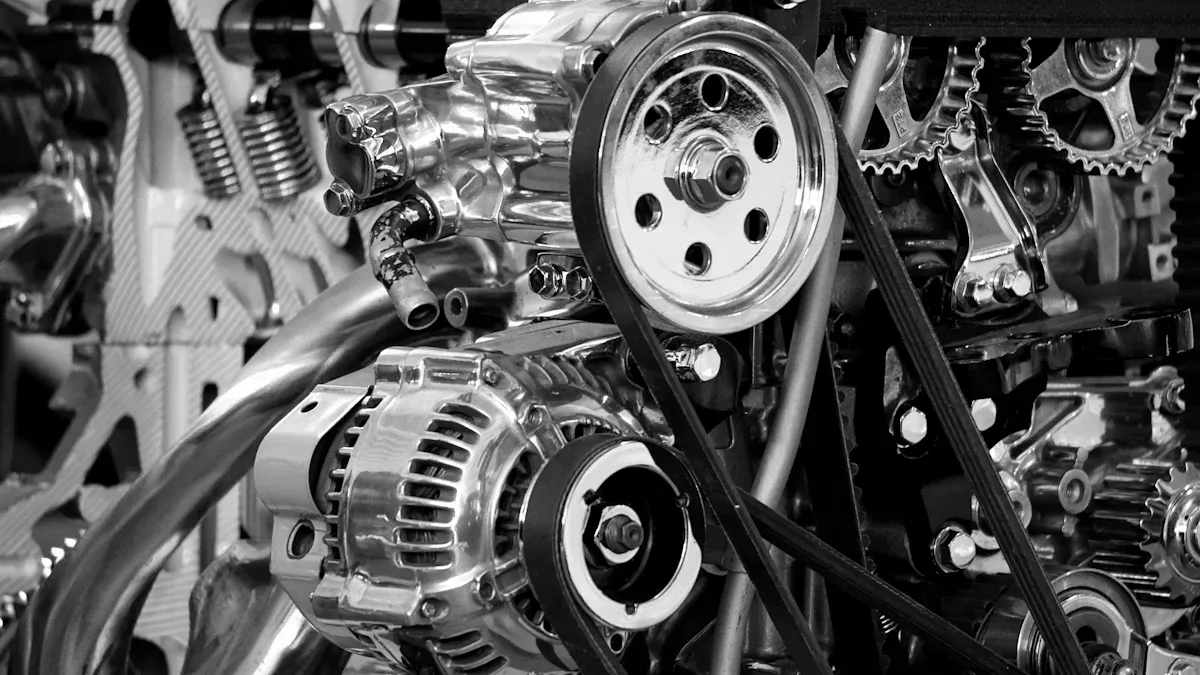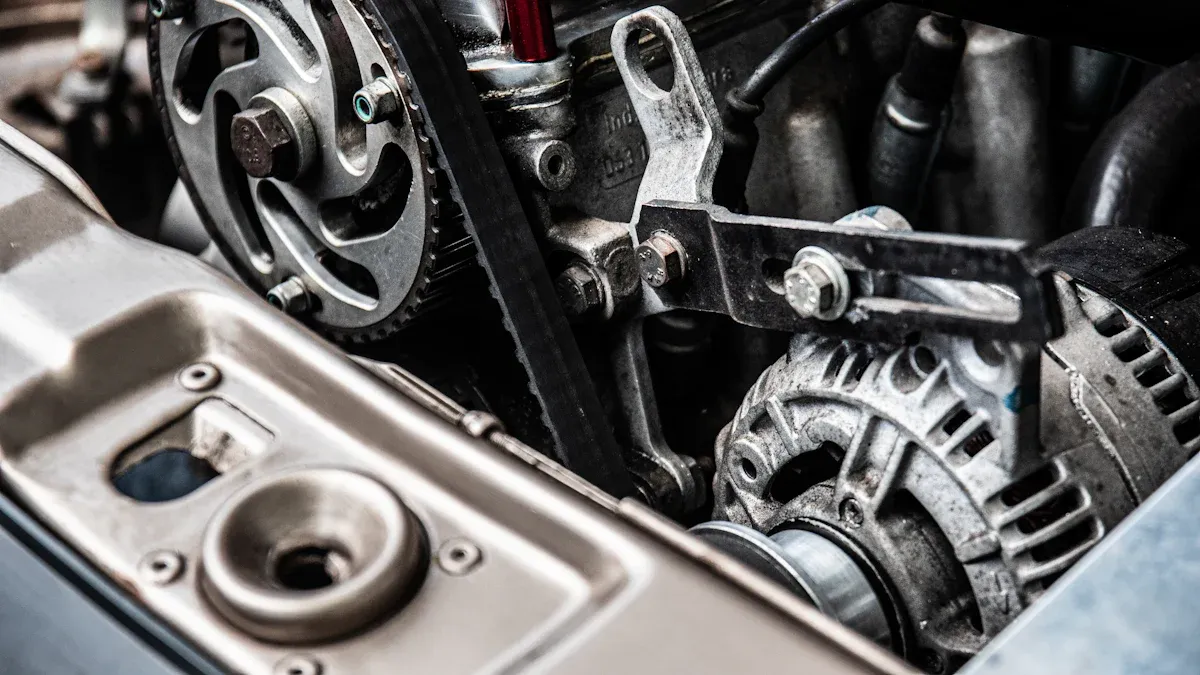
TAC Coating, or Tantalum Carbide Coating, improves automotive components by enhancing their durability and performance. With exceptional hardness and wear resistance, it withstands extreme conditions. Unlike SiC coating, it also offers superior thermal stability. Using advanced CVD coating methods, manufacturers apply TAC Coating to meet the demands of modern automotive engineering challenges effectively.
Key Takeaways
- TAC Coating makes car parts stronger and last longer.
- It shields parts from heat and rust, perfect for engines and brakes.
- TAC Coating costs more at first but saves money over time.
What is TAC Coating?
Composition and Properties
TAC Coating, short for Tantalum Carbide Coating, is a material made from tantalum and carbon atoms. These elements combine to form a compound with exceptional hardness and strength. This coating has a unique crystalline structure that makes it highly resistant to wear and tear. It also performs well under extreme temperatures, maintaining its stability even in harsh environments.
One of its standout properties is its ability to resist corrosion. Unlike other coatings, TAC Coating does not degrade easily when exposed to chemicals or moisture. Its thermal conductivity is another advantage, allowing it to handle heat without losing its effectiveness. These properties make it a reliable choice for automotive components that face constant stress.
How TAC Coating Works
TAC Coating works by creating a protective layer on the surface of automotive parts. Manufacturers apply it using a process called Chemical Vapor Deposition (CVD). In this process, tantalum and carbon gases react at high temperatures to form a thin, uniform layer on the component.
This layer acts as a shield, preventing damage from friction, heat, and corrosion. For example, when used on engine parts, the coating reduces wear caused by moving parts rubbing against each other. It also helps maintain performance by protecting components from thermal stress. By extending the lifespan of these parts, TAC Coating ensures better reliability and efficiency in vehicles.
Benefits of TAC Coating for Automotive Components

Durability and Wear Resistance
TAC Coating significantly enhances the durability of automotive components. Its exceptional hardness creates a tough barrier that protects parts from wear caused by friction. When you think about engine components or gears, these parts constantly rub against each other. Over time, this friction can lead to damage. TAC Coating reduces this wear, ensuring the components last longer and perform reliably.
Another advantage is its resistance to surface deformation. Even under heavy loads or high-pressure conditions, the coating maintains its integrity. This makes it ideal for parts like pistons and bearings, which experience constant stress. By choosing TAC Coating, you ensure your vehicle’s critical components remain in top condition for extended periods.
Thermal Stability and Corrosion Protection
Automotive components often face extreme temperatures and exposure to corrosive substances. TAC Coating excels in these challenging environments. It withstands high heat without breaking down, making it perfect for engine parts and exhaust systems.
Corrosion is another common issue, especially for parts exposed to moisture or chemicals. TAC Coating forms a protective layer that prevents rust and chemical damage. For example, brake components coated with TAC remain unaffected by road salt or humidity. This protection ensures your vehicle operates safely and efficiently, even in harsh conditions.
Long-Term Cost Efficiency
Investing in TAC Coating may seem costly upfront, but it saves you money in the long run. By extending the lifespan of automotive components, it reduces the need for frequent replacements. You also spend less on maintenance since the coated parts resist wear and corrosion.
Additionally, improved performance means your vehicle operates more efficiently. This can lead to savings on fuel and other operational costs. When you consider the overall benefits, TAC Coating proves to be a cost-effective solution for modern automotive needs.
Applications of TAC Coating in the Automotive Industry

Commonly Coated Components
TAC Coating plays a vital role in protecting critical automotive components. You will often find it applied to engine parts like pistons, valves, and cylinder liners. These components endure constant friction and high temperatures, making them prone to wear and tear. By adding a layer of TAC Coating, manufacturers ensure these parts last longer and perform more efficiently.
Transmission gears also benefit from this coating. The coating reduces surface damage caused by repeated contact between gear teeth. Brake rotors and calipers are another example. These parts face exposure to moisture, road salt, and extreme heat during braking. TAC Coating shields them from corrosion and thermal stress, ensuring reliable performance.
Use in High-Performance Vehicles
High-performance vehicles demand components that can handle extreme conditions. TAC Coating meets these demands by enhancing the durability and efficiency of key parts. For example, in sports cars, the coating improves the performance of turbochargers and exhaust systems. These parts operate at very high temperatures, and the coating prevents heat-related damage.
You will also find TAC Coating in racing vehicles. It protects suspension components and bearings, which experience intense stress during high-speed maneuvers. By using TAC Coating, manufacturers ensure these vehicles maintain peak performance under challenging conditions. This makes it an essential choice for anyone seeking reliability and efficiency in high-performance applications.
Practical Considerations for TAC Coating
Cost and Implementation
When considering TAC Coating, you might wonder about its cost and how it is applied. The initial investment can seem high because of the advanced technology involved in the coating process. However, the long-term benefits often outweigh the upfront expense. By reducing wear and extending the lifespan of components, TAC Coating saves you money on replacements and repairs over time.
The implementation process requires specialized equipment and expertise. Manufacturers use Chemical Vapor Deposition (CVD) to apply the coating. This method ensures a uniform layer that adheres tightly to the surface. While the process may take time, the results deliver unmatched durability and performance. If you are looking for a reliable solution, TAC Coating offers excellent value.
Maintenance and Longevity
TAC Coating requires minimal maintenance, which makes it a practical choice for automotive components. Once applied, the coating forms a durable shield that resists wear, corrosion, and heat. You won’t need to worry about frequent upkeep or reapplication.
The longevity of TAC Coating is another key advantage. It remains effective for years, even under extreme conditions. For example, engine parts coated with TAC maintain their performance despite constant friction and high temperatures. This durability ensures your vehicle operates efficiently for longer periods.
Material Compatibility
Before choosing TAC Coating, you should consider its compatibility with different materials. This coating works well with metals commonly used in automotive components, such as steel and aluminum. Its strong adhesion ensures a seamless bond, enhancing the part’s overall strength.
However, not all materials are suitable for TAC Coating. For instance, plastics or composites may not withstand the high temperatures required during the application process. Consulting with experts can help you determine if TAC Coating is the right choice for your specific needs.
TAC Coating offers unmatched benefits for automotive components. It enhances durability, resists wear, and protects against heat and corrosion. These advantages make it a practical solution for improving vehicle performance and longevity. By choosing TAC Coating, you ensure your components last longer and perform better. Explore this innovative option to meet modern automotive demands.
FAQ
1. Is TAC Coating suitable for all automotive components?
TAC Coating works best on metal parts like steel and aluminum. It’s not ideal for plastics or composites due to high application temperatures.
2. How long does TAC Coating last on automotive parts?
TAC Coating lasts for years under extreme conditions. Its durability ensures reliable performance without frequent reapplication or maintenance.
3. Does TAC Coating affect the weight of components?
The coating adds a thin layer, so it doesn’t significantly increase weight. You’ll maintain performance without compromising efficiency.
💡 Tip: Consult experts to ensure TAC Coating compatibility with your specific materials and components.


